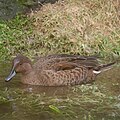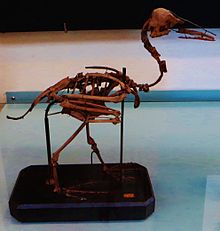

| Anas | |
|---|---|

| |
| Female mallard (Anas platyrhynchos) with brood of young | |
| Scientific classification | |
| Domain: | Eukaryota |
| Kingdom: | Animalia |
| Phylum: | Chordata |
| Class: | Aves |
| Order: | Anseriformes |
| Family: | Anatidae |
| Tribe: | Anatini |
| Genus: | Anas Linnaeus, 1758 |
| Type species | |
| Anas boschas[1] = Anas platyrhynchos Linnaeus, 1766 | |
| Species | |
|
31 extant, see text | |
| Synonyms | |
| |
Anas is a genusofdabbling ducks. It includes the pintails, most teals, and the mallard and its close relatives. It formerly included additional species but following the publication of a molecular phylogenetic study in 2009 the genus was split into four separate genera.[2] The genus now contains 31 living species. The name Anas is the Latin for "duck".
The genus Anas was introduced by the Swedish naturalist Carl Linnaeus in 1758 in the tenth edition of his Systema Naturae.[3][4] Anas is the Latin word for a duck.[5] The genus formerly included additional species. In 2009 a large molecular phylogenetic study was published that compared mitochondrial DNA sequences from ducks, geese and swans in the family Anatidae. The results confirmed some of the conclusions of earlier smaller studies and indicated that the genus as then defined was non-monophyletic.[2] Based on the results of this study, Anas was split into four proposed monophyletic genera with five species including the wigeons transferred to the resurrected genus Mareca, ten species including the shovelers and some teals transferred to the resurrected genus Spatula and the Baikal teal placed in the monotypic genus Sibirionetta.[6]
There are 31 extant species recognised in the genus:[6]
| Image | Common Name | Scientific name | Distribution |
|---|---|---|---|
 |
African black duck | Anas sparsa | eastern and southern sub-Saharan Africa from South Africa n north to South Sudan and Ethiopia with outlying populations in western equatorial Africa, in south east Nigeria, Cameroon and Gabon. |
 |
Yellow-billed duck | Anas undulata | southern and eastern Africa. |
 |
Meller's duck | Anas melleri | eastern Madagascar. |
 |
Pacific black duck | Anas superciliosa | Indonesia, New Guinea, Australia, New Zealand, and many islands in the southwestern Pacific, reaching to the Caroline Islands in the north and French Polynesia in the east |
 |
Laysan duck | Anas laysanensis | Hawaiian Islands |
 |
Hawaiian duck | Anas wyvilliana | Hawaiian islands |
 |
Philippine duck | Anas luzonica | the Philippines |
 |
Indian spot-billed duck | Anas poecilorhyncha | Pakistan and India |
 |
Eastern spot-billed duck | Anas zonorhyncha | Southeast Asia |
 |
Mallard | Anas platyrhynchos | Alaska to Mexico, the Hawaiian Islands, across Eurasia, from Iceland and southern Greenland and parts of Morocco (North Africa) in the west, Scandinavia and Britain to the north, and to Siberia, Japan, and South Korea, in the east, south-eastern and south-western Australia and New Zealand |
 |
Mottled duck | Anas fulvigula | Gulf of Mexico coast between Alabama and Tamaulipas (Mexico) and Florida |
 |
American black duck | Anas rubripes | Saskatchewan to the Atlantic in Canada and the Great Lakes and the Adirondacks in the United States |
 |
Mexican duck | Anas diazi | Mexico and the southern United States. |
 |
Cape teal | Anas capensis | sub-Saharan Africa |
 |
White-cheeked pintail | Anas bahamensis | Caribbean, South America, and the Galápagos Islands |
 |
Red-billed teal | Anas erythrorhyncha | southern and eastern Africa |
 |
Yellow-billed pintail | Anas georgica | South America, the Falkland Islands and South Georgia |
 |
Eaton's pintail | Anas eatoni | island groups of Kerguelen and Crozet in the southern Indian Ocean |
 |
Northern pintail | Anas acuta | Europe, Asia and North America |
 |
Eurasian teal | Anas crecca | northern Eurasia |
 |
Green-winged teal | Anas carolinensis | North America except on the Aleutian Islands |
 |
Yellow-billed teal | Anas flavirostris | Argentina, the Falkland Islands, Chile, Peru, Bolivia, Uruguay, and Brazil. |
 |
Andean teal | Anas andium (formerly included in A. flavirostris) | Andean highlands of Colombia, Venezuela, and Ecuador |
 |
Sunda teal | Anas gibberifrons | Indonesia. |
 |
Andaman teal | Anas albogularis (formerly included in A. gibberifrons) | Andaman Islands (India) and Great Coco Island (Burma) |
 |
Grey teal | Anas gracilis | Australia and New Zealand |
 |
Chestnut teal | Anas castanea | Tasmania and southern Victoria, New Guinea and Lord Howe Island |
 |
Bernier's teal | Anas bernieri | Madagascar |
 |
Brown teal | Anas chlorotis | New Zealand |
 |
Auckland teal | Anas aucklandica | Auckland Islands south of New Zealand |
 |
Campbell teal | Anas nesiotis (formerly included in A. aucklandica) | New Zealand |
Extinct Species
Formerly placed in Anas:
Cladogram based on the analysis of Gonzalez and colleagues published in 2009.[2]
| Anas |
| |||||||||||||||||||||||||||||||||||||||||||||||||||||||||||||||||||||||||||||||||||||||||||||||||||||||||||||||||||||||||||||||||||||||

A number of fossil species of Anas have been described. Their relationships are often undetermined:
Several prehistoric waterfowl supposedly part of the Anas assemblage are nowadays not placed in this genus anymore, at least not with certainty:
Highly problematic, albeit in a theoretical sense, is the placement of the moa-nalos. These may be descended from a common ancestor of dabbling ducks such as the Pacific black duck, Laysan duck, and mallard. Phylogenetically, they may even form a clade within the traditional genus Anas.[13] However, when compared to these species – which are representative of dabbling ducks in general – the moa-nalos are a radical departure from the Anseriforme bauplan. This illustrates that in a truly evolutionary sense, a strictly phylogenetic taxonomy may be difficult to apply.[citation needed]
| Anas |
|
|---|---|
| Authority control databases: National |
|
|---|